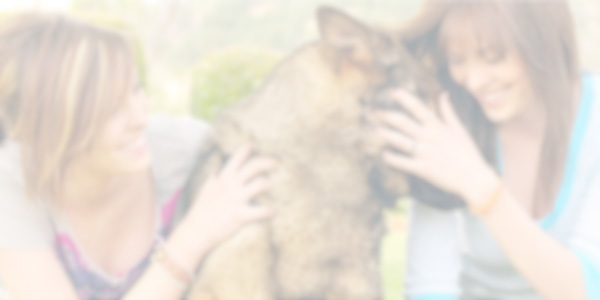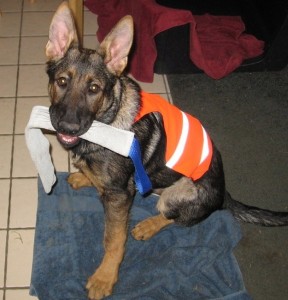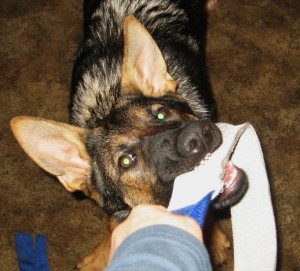Rainy Day Activities
When storm after storm comes rolling through with rain, wind, and more rain, even the most well-behaved and well-trained dog can come down with “cabin fever”. Boredom can result in annoying and even destructive tendencies, and with a high energy, intelligent breed like the German Shepherd Dog, there’s no telling what trouble they might get into!
To help stave off the rainy day blues and boredom, try one of the following indoor games. The games below are variations of the actual training we do with our working dogs and trained German Shepherds for sale, and each “game” provides a unique and fun way to bond and interact with your dog.
“Find It!”
This is essentially hide-and-seek with your dog’s favorite toy. Hide your dog’s favorite toy somewhere in the house, then bring your dog into the room where you have hidden it and excitedly tell him to “Find it! Find your toy!” Encourage him as needed until he finds it. Reward him with a quick little game of tug or fetch with his toy (be careful of slick floors!), and then go hide the toy again. As your dog becomes more adept at using his nose to find his toy, you may increase the difficulty of the hiding places. This sort of activity is similar to an area search, where the dog must find a specific object in a given area.
Article Indication
When we train our dogs in tracking, we teach them an “article indication” to show they have located an article touched by the tracklayer. For most of our dogs, a passive “sit” or “down” at the article is used. You can also train your own dog to indicate various articles, which can be invaluable if you ever lose your keys and need help finding them!
Select an “article” to start with. It could be a piece of leather or carpet, a small paper plate, a glove, or some other safe object that the dog won’t swallow if he picks it up. A small paper plate or large square of leather may be easiest to start with. Bring lots of treats and the “article” into a quiet room with your dog. Place the article in the center of the floor, and encourage your dog to look at it. Mark the behavior with a “Yes!” and reward with food. Continue to reward for looking at or investigating the article. Then ask for a little more–touching it with his nose or paw, rather than just looking at it–and reward immediately.
Dogs eager to learn the game will soon be pawing, licking, or biting the article, at which point you can to introduce a “sit” or “down” to indicate the article. Begin moving the article around the room, and encourage your dog to go up to it and “indicate” it. Always reward him as soon as he offers the correct indication! If you attach a cue to the behavior (such as “search”), you can eventually work up to placing the article in another room and asking the dog to “search” for it. When the dog shows he understands the indication, begin to use different articles (including your car keys!) to help him generalize the behavior.
Obedience Training
Many people think of obedience training as dull and boring, but it doesn’t have to be! Obedience can be fun and exciting for both you and your dog, and it also helps cement your role as pack leader. We use both food and toys (ball on a rope or a special tug) to reward our dogs for obedience, and it becomes an exciting game to the dog.
Try mixing obedience exercises with an enjoyable game of tug for both physical and mental stimulation for your dog. Ask the dog to “sit” or “down”, and when he complies immediately say “Yes” and reward with a round of tug. Ask the dog to release the tug, then reward again immediately with another round of tug. Then repeat the game, but mix it up: two or three commands in a row before rewarding, one command the next time, and a reward for releasing on command after that. Keep the game exciting and short, and end it before your dog tires of it. You can use play or food to teach or reinforce a wide variety of cues: sit, down, stand, here, heel, back up, “speak”, and even tricks like bowing or rolling over.
Last but not least: if your dog still seems to have a case of the rainy day blues, then provide him with a safe and stimulating chewing object like a big bully stick, meaty knuckle bone, or stuffed Kong toy (always supervise his chewing sessions!). Sometimes a good chew is all they need! And if even this does not take the edge off, then what’s a little walk in the rain?
Happy training, and stay dry,
CK



